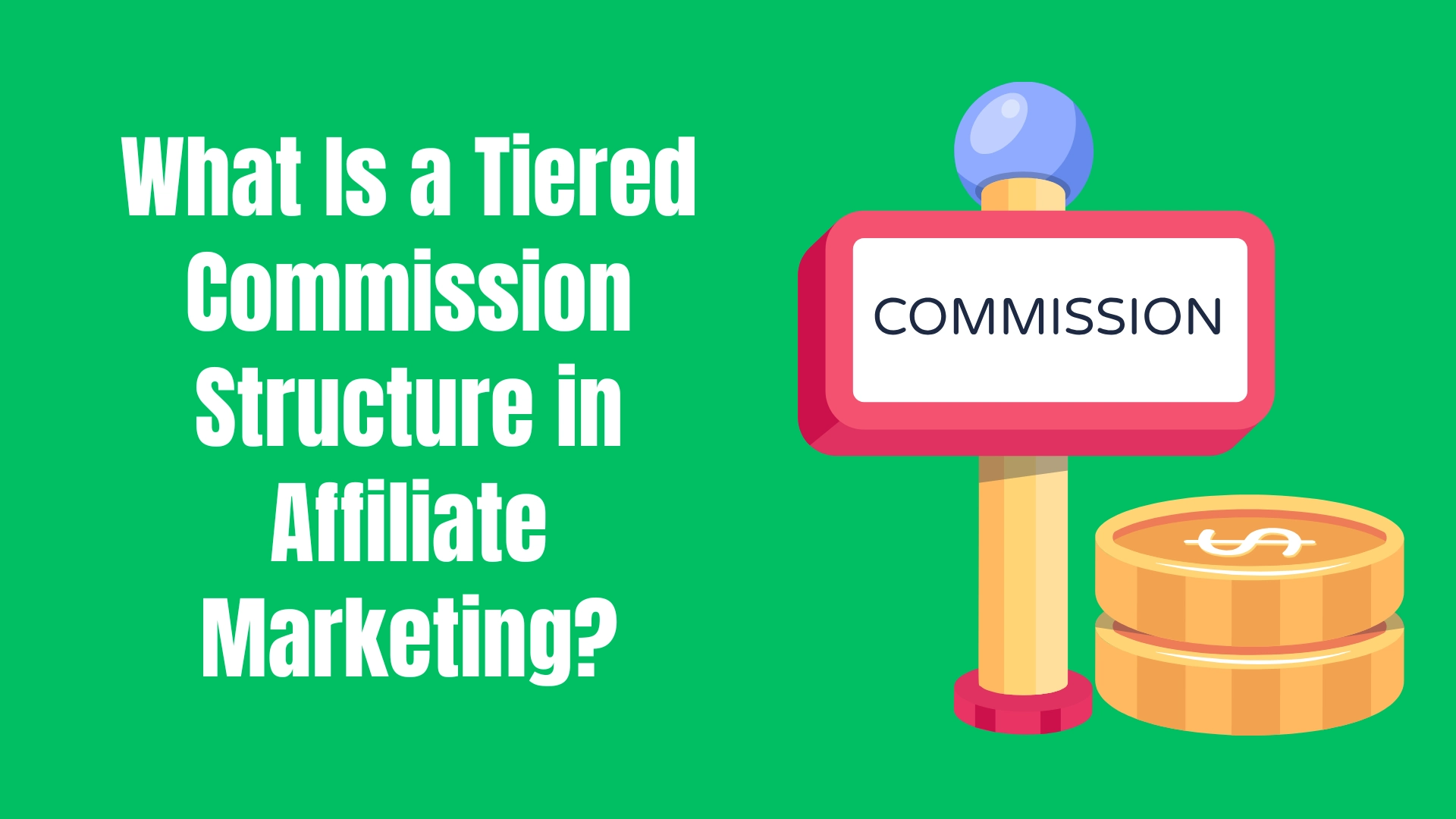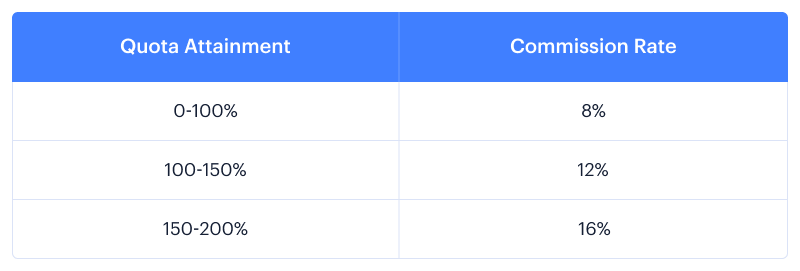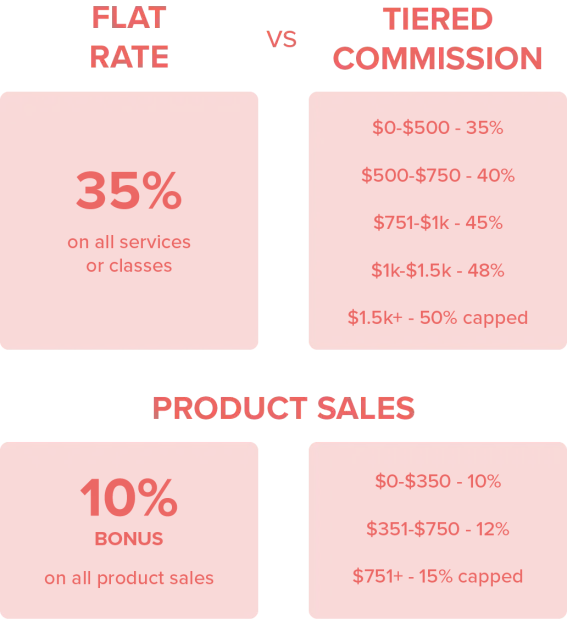What Is a Tiered Commission Structure in Affiliate Marketing and How Does It Work?

Affiliate marketing is one of the easiest ways to earn online without creating a product. You promote other people’s products and earn a commission for every sale. Simple, right? However, not all commission structures are the same.
Some programs pay a flat rate per sale, while others reward you for driving higher sales volume. That’s where tiered commission structures come in.
A tiered commission structure is a payment model that increases your commission rate as you generate more sales. Instead of earning a fixed percentage on every sale, you unlock higher commissions when you hit certain sales targets.
For example, an affiliate program might start you at a 5% commission per sale. But if you refer 10 customers, your commission jumps to 7%. Refer to 20, and it goes up to 10%. The more you sell, the more you earn.
This system benefits both affiliates and businesses. Affiliates get a strong incentive to push for higher sales, knowing they’ll make more per transaction. Businesses, on the other hand, encourage consistent promotion without upfront costs.
Instead of paying higher commissions to every affiliate, they reward those who prove they can drive real results. It’s a win-win model that keeps both sides motivated.
For serious affiliates, a tiered structure is the key difference. It turns small commissions into a scalable income stream. Instead of being stuck at one rate, you have room to grow. The more effort you put in, the bigger your rewards. That’s why experienced marketers prefer programs that offer tiered commissions over those with flat rates.
Now, let’s break down exactly how tiered commissions work and why they can significantly boost your affiliate income.
Key Takeaways
- More Sales, Higher Commissions – Tiered structures increase your commission rate as you refer more sales.
- Motivates Affiliates – Higher earnings push affiliates to promote more and stay consistent.
- Great for Businesses – Companies reward top performers without overpaying new affiliates.
- Scalable Income – The more effort you put in, the bigger your rewards grow.
- Better Than Flat Rates – Unlike fixed commissions, tiered models let you earn more over time.
- Works in Many Niches – Tiered commissions apply to SaaS, e-commerce, and other industries.
Understanding Tiered Commission Structures
Affiliate marketing rewards you for driving sales, but not all commission structures work the same. A tiered commission structure increases your commission rate as you hit certain sales milestones. The more sales you generate, the higher your earnings per sale. This model pushes affiliates to perform better while giving businesses a way to reward top promoters.

How Tiered Commissions Differ from Flat-Rate Commissions
Flat-rate commissions pay the same percentage or fixed amount per sale, no matter how many you generate. Whether you bring in one sale or a hundred, your rate doesn’t change. It’s predictable but doesn’t incentivize growth.
Tiered commissions, on the other hand, have different levels. As you move up, your commission percentage increases. This encourages affiliates to scale their efforts since higher sales bring in better rewards. It’s a win-win—affiliates earn more, and businesses get more exposure.

Here are Some Examples of Tiered Commission Models in Action
- E-Commerce Affiliate Programs: A company selling online courses might start affiliates at a 10% commission. After 20 sales, the rate jumps to 15%, then 20% after 50 sales.
- SaaS (Software as a Service) Companies: Some software brands offer a 25% commission for the first five referrals, then 30% for 10+ sales. High performers might reach 40%.
- Subscription-Based Products: A VPN service might pay $10 per signup initially. After 30 sales, affiliates start earning $15 per signup.
- Multi-Tier Affiliate Programs: Some businesses allow affiliates to recruit sub-affiliates. You earn a percentage from your direct sales and a smaller cut from sales made by those you refer.
Tiered commission structures benefit both sides. Affiliates stay motivated to push for higher sales, and businesses see more engagement from their marketing partners. It’s a strategy that turns effort into bigger rewards.
How a Tiered Commission Structure Works
A tiered commission structure rewards effort. The more sales you bring in, the higher your commission rate climbs. It’s a system designed to push affiliates to scale their efforts while giving businesses a way to compensate top performers fairly.
Performance-Based Progression: How Affiliates Move Up Tiers
Affiliates don’t start at the top. You begin at the lowest tier, earning a base commission rate. As you hit certain sales or revenue milestones, your rate increases.
For example, a program might start affiliates at 5%. Once you generate 20 sales, your commission jumps to 7%. At 50 sales, it goes up to 10%. This structure keeps you motivated and encourages consistency.
I’ve seen it firsthand. When I started, I was stuck at the base rate for months. But once I refined my strategy and started bringing in more conversions, my earnings grew—not just from volume but from higher commissions per sale. That’s the power of a tiered system.
Common Commission Tiers: Example Breakdown
Most programs follow a structure like this:
- Tier 1: 5% commission (0–20 sales)
- Tier 2: 7% commission (21–50 sales)
- Tier 3: 10% commission (51+ sales)
Some companies adjust these based on revenue rather than sales volume. For example, a luxury product brand might increase commissions when an affiliate drives $5,000, $10,000, and $20,000 in revenue rather than a set number of sales.
Revenue vs. Sales-Based Tiers
Programs structure their tiers differently. Some base progression on the number of sales. Others focus on the total revenue generated.
- Sales-Based Tiers: You move up based on how many products or services you sell. This works best for programs where each sale has a similar value, like digital products or subscriptions.
- Revenue-Based Tiers: Your commission rate increases as the total revenue from your referrals grows. This benefits affiliates promoting high-ticket items or services with varied pricing.
Both models have their advantages. A sales-based structure keeps things simple, while a revenue-based model rewards affiliates who attract higher-paying customers. Knowing which system a program uses helps you plan your strategy effectively.
At the end of the day, tiered commissions reward those who put in the work. If you can consistently drive sales or revenue, you’ll unlock better earnings—and that’s what makes this model so powerful.
Benefits of a Tiered Commission System
A tiered commission structure isn’t just about making more money—it’s about creating a system that benefits both sides. Affiliates get rewarded for putting in effort, and businesses keep their marketing costs under control. This model encourages growth, engagement, and long-term partnerships.
For Affiliates: Higher Earnings and Motivation to Scale
When I started in affiliate marketing, I earned a flat commission. It was fine at first, but over time, I felt stuck. No matter how much effort I put in, my earnings didn’t grow beyond a certain point. That changed when I joined a tiered program.
With tiered commissions, you don’t just make more by selling more—you also increase your rate. Instead of earning a fixed 5%, you might hit 7% or 10% after reaching certain sales goals. That extra percentage makes a huge difference in long-term earnings.
This system also pushes affiliates to improve. It encourages better content, smarter traffic strategies, and more consistency. When there’s a clear reward for reaching the next level, it’s easier to stay focused and motivated.
For Businesses: More Engagement, Smarter Marketing Costs
Businesses love tiered commissions because they only pay higher rates to proven affiliates. A company isn’t shelling out 10% commissions to someone who just joined. They’re rewarding those who bring consistent results.
This model also keeps affiliates engaged. If someone sees they’re close to a higher commission tier, they’ll push harder to reach it. That means more sales, more traffic, and stronger relationships between brands and affiliates.
From a business perspective, it’s smart. Instead of spending blindly on ads, companies pay affiliates based on performance. They only increase payouts when results justify it. That’s controlled, cost-effective marketing.
Win-Win Model: Building Long-Term Partnerships
Flat commissions don’t always keep affiliates around. If there’s no room to grow, people move on to better-paying programs. But a tiered structure gives them a reason to stick around. The longer they promote, the higher their potential earnings.
This benefits everyone. Affiliates stay loyal, and businesses get long-term partners who genuinely understand their products. It’s not just about making quick sales—it’s about building relationships that last.
I’ve personally experienced this. Some of my best affiliate partnerships started with small commissions. But as I proved my worth, my earnings grew, and so did my trust in those brands. That’s the power of a system designed to reward growth.
Challenges and Considerations in a Tiered Commission Structure
A tiered commission system has big benefits, but it’s not perfect. Some affiliates struggle to reach higher tiers, and not all programs are structured fairly. I’ve learned this the hard way. When choosing a tiered program, you need to be smart. Not every high-paying commission plan is worth your time.
The Challenge of Reaching Higher Tiers
When I first joined a tiered commission program, I was excited. The top tier offered a great payout, but I quickly realized something—it wasn’t easy to reach. The program had strict sales targets, and missing them meant staying stuck at a lower rate.
This is where some affiliates get frustrated. If the sales goals are too high, the model feels less like an opportunity and more like a trap. That’s why it’s important to study the structure before signing up. Some programs make it nearly impossible for smaller affiliates to move up.
1. Fairness Concerns: Is the Program Worth It?
Not all tiered commission programs are built fairly. Some companies use them as bait—promising high commissions but making the top tiers unrealistic. Others set up unfair rules, like requiring affiliates to maintain their sales every month or risk being dropped to a lower tier.
I’ve fallen for this before. I worked hard to reach a higher tier, only to realize I had to start from scratch every month. That’s when I learned to read the fine print. A good program should offer fair, attainable goals, not impossible ones.
2. Best Practices for Structuring a Tiered Commission Model
For businesses running an affiliate program, fairness is key. The best tiered models set reasonable targets and reward steady growth. If tiers are too far apart, affiliates lose motivation. If they’re too easy, the company risks overpaying for minimal effort.
A well-balanced system should:
- Offer clear, realistic milestones.
- Allow affiliates to maintain their tier once they reach it.
- Provide long-term rewards for top performers.
Businesses that get this right keep affiliates motivated and engaged. I’ve stayed loyal to programs that gradually increase payouts without punishing affiliates for small dips in performance.
3. Choosing the Right Affiliate Program
Not every program is worth your effort. Before committing, I always ask:
- Are the commission tiers realistic?
- Do earnings reset every month, or can I maintain my level?
- Is there a history of affiliates successfully reaching higher tiers?
If a program sets impossible goals or keeps moving the target, it’s not worth the time. I focus on brands that value their affiliates and reward consistent effort.
A tiered commission structure can be a great way to grow your income—if you pick the right one. Understanding the challenges and knowing what to look for makes all the difference.
Must Read: How to Choose the Best Affiliate Programs for Maximum Profit in 2025
Examples of Companies Using Tiered Commission Models
Okay, let’s look at how companies use tiered commission models. Essentially, this structure rewards employees based on the amount they sell or achieve. Companies like Salesforce and Amazon have used this to motivate sales teams.
In their models, once a salesperson hits tier-specific targets, they earn increasing commissions. The setup encourages employees to push past initial goals. I’ve seen it drive performance by making higher-tier goals feel more attainable. Simple but effective!
Many companies use tiered commissions to reward top performers. I’ve seen programs like WP Engine and HostGator use a basic rate that increases with more referrals. These tiered structures motivate affiliates to work harder, as clear sales targets encourage growth over time.
Different industries apply tiered commissions in unique ways. In the hosting industry, commissions rise as you get more sign-ups. When dealing with digital products, commissions are often based on revenue instead of sales numbers. SaaS companies tend to offer recurring revenue tiers, which can be a strong incentive.
Must Read: 15 Best SaaS Affiliate Programs That You Need to Join
I’ve worked with companies that used tiered models, like a VPN service where commissions increased as I hit more sign-ups. It certainly pushed me to optimize my approach. This model motivates consistent performance and creates a win-win strategy.
Tips for Maximizing Earnings with Tiered Commissions
Maximizing earnings with tiered commissions isn’t just about working harder—it’s about working smarter. The right strategy can push you into higher commission brackets faster, helping you make more without adding extra hours to your day. Here’s how to move up the ranks and get the most from your efforts.
1. Move Up Commission Tiers Faster
Reaching higher commission levels requires a focused approach. Promoting too many products can slow your progress. Instead, stick to a niche and consistently drive sales. Remember also to track your perfomance. Knowing which strategies work allows for better decision-making. The more consistent sales you generate, the faster you unlock higher payouts.
2. Use Content Marketing and SEO for Better Conversions
Quality content attracts buyers and builds trust. Blog posts, videos, and email marketing help drive conversions without aggressive selling. SEO plays a major role in long-term success. Optimizing content for search engines brings in free, targeted traffic. The goal is simple—create helpful content, rank well, and convert visitors into buyers.
3. Build Strong Relationships with Brands
Affiliate success isn’t just about sales—it’s about partnerships. Strong relationships with brands can lead to exclusive deals, higher commissions, and better support. Some companies offer bonuses for top-performing affiliates. Engaging with affiliate managers, providing feedback, and staying updated on promotions can open doors to new opportunities.
The bottom line? Stay consistent, know what converts, and keep building. The more you refine your approach, the bigger the payouts.
Conclusion
A tiered commission structure is a powerful model that benefits both affiliates and businesses. Unlike flat-rate commissions, it rewards performance by increasing earnings as sales grow. This system pushes affiliates to scale their efforts while helping businesses attract committed partners. It’s a win-win strategy that drives long-term success.
For affiliates, moving up the tiers takes strategy. Consistent sales, strong marketing, and relationship-building make a difference. Those who understand SEO, content marketing, and audience engagement can maximize their earnings. The effort pays off with higher commissions and better opportunities.
For businesses, tiered commissions create a motivated affiliate network. They encourage quality promotions while keeping marketing costs in check. By structuring tiers wisely, companies can attract top-tier affiliates and scale revenue. Whether you’re an affiliate looking to increase earnings or a business structuring an affiliate program, a tiered model offers a sustainable path to growth.
Frequently Asked Questions
What is a tiered commission structure in affiliate marketing?
A tiered commission structure is a system where affiliates earn higher commission rates as they reach specific sales milestones. Instead of a fixed percentage, commissions increase based on performance. For example, an affiliate may start at 5%, move to 7% after generating $1,000 in sales, and reach 10% at $5,000. This model rewards consistent effort and encourages affiliates to drive more sales.
How is a tiered commission structure different from a flat-rate commission?
A flat-rate commission offers the same percentage for every sale, no matter how many sales an affiliate generates. A tiered system, on the other hand, increases the commission rate as affiliates hit certain targets. This means affiliates have more incentive to scale their efforts, while businesses can reward top performers without overpaying beginners.
What are the main benefits of a tiered commission system for affiliates?
The biggest benefit is the potential for higher earnings. Instead of earning a fixed percentage, affiliates can work their way up to higher commission rates. This structure also motivates affiliates to stay consistent and optimize their strategies. The more effort they put in, the bigger the reward.
How do businesses benefit from offering tiered commissions?
Businesses get more engaged and productive affiliates. Since affiliates are motivated to reach higher commission levels, they promote products more aggressively. This leads to increased brand exposure, higher sales, and better marketing results. Additionally, businesses only pay higher commissions when affiliates deliver more revenue, keeping costs balanced.
What strategies help affiliates move up the commission tiers faster?
To climb the tiers quickly, affiliates should focus on driving high-quality traffic and increasing conversions. This includes creating valuable content, using SEO to attract organic visitors, and leveraging email marketing. Affiliates who build trust with their audience and choose high-converting products can scale their commissions faster.
Are tiered commission structures better than flat-rate models for beginners?
For beginners, a tiered structure can be both motivating and challenging. While it offers the chance to earn more over time, new affiliates may start at lower commission rates. Those who are committed to learning, testing, and improving their marketing strategies will find a tiered system rewarding in the long run.







Great post!